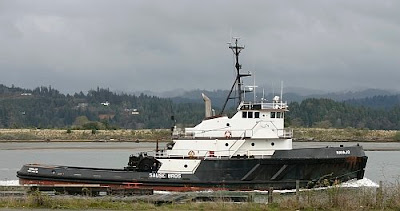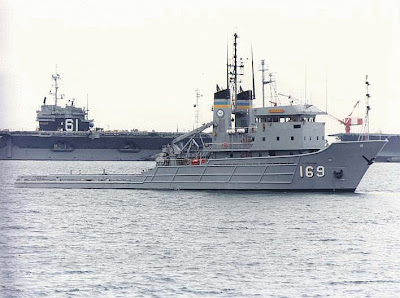
Just one picture today of a tug called the Navajo.
This boat was in San Francisco within the last year or so with a tow according to the San Francisco Bay Navigation District . I also found a log of the Navajo in Hawaii and on further reading found it is classified as an Ocean Going Tug.
I found more about Tugs and Navajo so here it is




Here is also an article I found and Navajo was a class of Tugs during WWI and WWII.
"They were the workhorses of the fleet--small auxiliary ships that helped to save some of the biggest and most powerful warships. They were, and are, the towing, diving, salvage and rescue ships of the U.S. Navy. Perhaps the best known among the ocean-going tugs of the World War II era were the 205-foot fleet tugs of the Navajo class, also referred to as the Indian class since they were named for tribes of native North Americans. There were 70 of these ships built, originally classified as ATs, but redesignated ATFson May 15, 1944.
The lead ship, Navajo (AT-64), was built at Bethlehem Shipbuilding Corp., Staten Island, and commissioned on Jan. 26, 1940. She was lost Sept. 12, 1943, when an explosion occurred at sea. Lost with her were 17 sailors.
Sister ship Seminole (AT-65) joined the fleet in March 1940. Along with Navajo, she operated at Pearl Harbor during the hectic days that followed the Japanese surprise attack. She, too, was a casualty of war, lost a year earlier than the Navajo.
Seminole was at Tulagi on Oct. 18, 1942, offloading aviation gasoline and ammunition with YP-284 (a yard patrol craft) in company. The two small ships were about three and a half miles east of Lunga Point when a trio of enemy destroyers appeared. Seminole immediately got underway, but was outgunned and outrun. Seminole and YP-284 both were hit, caught fire and sunk. Most of the Japanese bullets passed through the tug's thin skin and didn't explode, with the relatively fortunate result that only one Seminole crew member was lost.
Nauset was lost in 1943 during the Sicily invasion, and Sarsi was lost after the war. As a class, however, these sturdy tugs were survivors.
The 205-footers were well suited to their missions of open-ocean towing, emergency salvage and fire fighting in naval combat areas. They were long-legged ships with superb endurance resulting from the 96,000 gallons of fuel that they could carry. The four diesel engines used for main propulsion developed 3,000 shaft horse power from the electric motor. The 13-foot screw could tow large vessels long distances. Examples include drydock sections and damaged capital ships being moved to or from the theater of operations. These 205-foot tugs had salvage pumps, 8,000-pound eells anchors ideal for salvage work and other special equipment for conducting or assisting in salvage operations. They also had considerable fire-fighting capability.
The ATFs were distinctive ships with tall, straight bows, low freeboard amidships and a rounded stern above the single screw and rudder. ATFs 66-95 were built with a large stack, and ATFs 96 and later had a smaller stack with the main propulsion exhaust being discharged over the side at the waterline instead of through the funnel.
Call them tug boats, but ATFs were relatively large vessels, drawing 15 feet, and so not suited for close inshore work. At about 1,600 tons, these ships were not much smaller than early World War II destroyers and destroyer escorts. They were, however, rugged craft able to take punishment from working with damaged craft at close quarters, or from combat operations.
These tugs had teeth, too! The main gun was a 3-inch, .50-caliber, slow-fire mount. In their wartime configuration, however, these ships had 20 mm machine guns on both bridgewings and 40 mm anti-aircraft batteries in gun tubs aft on both sides. Depth charges were carried to sink submarines, if one, by chance, were to stumble upon an ATF. In later years much, if not all, of this armament was removed.
Before the Navajo class came into being, the Navy had a wide variety of older tugs. Some were unique civilian ships pressed into military service. Sixteen of them were Bird-class World War I minesweepers that were built on tug-type hulls, while some were one-of-a-kind naval vessels. During World War II, these ATs were reclassified as ATOs, with the "O" meaning old. A total of 36 ships carried the ATO designation.
Floyd Mathews was only 16 when he enlisted in the Navy in 1919. His 30-year career saw him rise to the rank of Lieutenant Commander and command of the fleet tug Chickasaw (ATF-83). He also served aboard a battleship and seven submarines. He found tugs comparatively relaxed and informal, but the work was long and hard.
"Salvage work was adventurous and gratifying," Mathews said. "But the work never ended until the job was done." Mathews served on the converted minesweepers Bobolink (ATO-20) and Kalima (ATO-23); the rescue and salvage ship Deliver (ARS-5); and finally the Chickasaw.
"You could be expected to get underway on a moment's notice on jobs such as search and rescue," he said. "Duty on a battleship was more of a rigid routine. You lived by the book," Mathews asserted.
"You would speak to an officer only when spoken to, or by request. Not so in smaller ships." The happiest moment in his naval career, he recalled, was when he received orders to command his fleet tug."
Quote of the Day ~
I'm thirty years old, but I read at the thirty-four-year-old level. ~ Dana Carvey
No comments:
Post a Comment